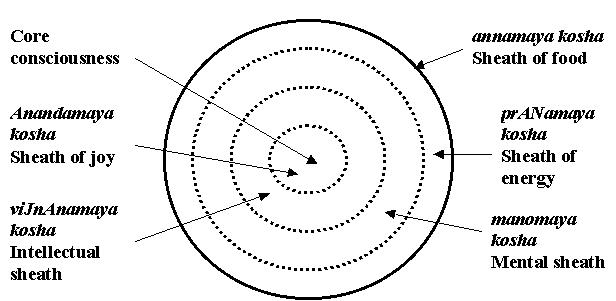|
yA devI sarva bhUteshu dayA rupeNa saMsthitA
namastassai
namastassai namastassai namo namaH
Again and again I bow to the devi who abides in all beings as compassion.
Now that we have seen the route that some people of distant
past took towards understanding the universe. I would like to examine the path they took to understand themselves. By doing
this, the hope is that we will then be able to put both the paths in perspective and that in turn will help us understand
our place in universe.
In describing human personality, teachers of vedAnta (gist
of knowledge) have often resorted to the metaphor of the onion. According to them human personality consists of layers within
layers, like layers of an onion. This is a brief overview of their thoughts.
Figure 1 depicts this understanding pictorially.
As shown in the schematic drawing, the unseen center of personality is the core consciousness
and our essential nature. It is progressively covered and obscured by several sheaths. For convenience it groups the sheaths
into five groups. These sheaths are first described in taittiriya upanishad as follows:
(1)
The innermost sheath is Anandamaya kosha or the sheath of bliss or joy.
(2) The next
sheath is the viJAnamaya kosha or the sheath of intellect or reasoning.
(3) The third
sheath is the manomaya kosha or the sheath of mind.
(4) The fourth sheath is the
prANamaya kosha or the sheath of energy or vital airs or life force.
(5) The outermost
sheath is the annamaya kosha or the sheath of food.
The outer most sheath, or
the sheath of food, is the gross body (sthula sharira) of the person. The innermost
sheath, or the sheath of joy, is the causal body (kAraNa sharira) of the person. The
three sheaths between the gross body and the causal body make up the subtle body (kshushma sharira)
of the person. Total personality of a person in this model is the sum of gross body, subtle body and the causal body.
The outer sheaths are described as denser and coarser than the inner sheaths, which are finer and subtler.

Figure 1. In this understanding of personality, the unseen center of personality
is the core consciousness. Five sheaths surround it. The sheaths get progressively subtler or finer as we go from outer sheaths
to inner sheaths.
The sheath of food is also called the gross body. The next three sheaths constitute the subtle body.
The sheath of joy is also called the causal body.
To recapitulate, at the core we are nothing but pure being, pure awareness, and naturally
blissful. This is our essence. This is our immutable aspect. It is indescribable, immeasurable and, as I will later show,
immanent. This is what I have called the essence or the core consciousness or the unseen center of personality in figure 1.
It is the source and substratum of what we are. All else emanates from this core and gives us character. These emanations
can be thought of as sheaths of personality that sequentially envelope our core consciousness, and muddle our view of core
consciousness. A common metaphor for the unseen center of personality is guhA or cave.
I think this is a very apt metaphor, for like a cave, our inner core is hidden behind layers of rock, mud and overgrowth.
These are the sheaths I show pictorially in figure 1. How many sheaths are there?
Perhaps quite a few, and people have speculated of as many as 72 sheaths. I prefer a version where sheaths can be conveniently
grouped into basic types if they are similar or closely related. Five sheaths (or five groups of sheaths) then seems
to be a good balance between too much oversimplification and unnecessary complexity.
The first sheath to wrap our core consciousness is the sheath of joy or bliss. It
is so called because it is nearest what is essentially bliss itself and acquires some blissfullness by proximity. It is also
what makes us seekers of bliss or joy. This sheath is the store house of unmanifested impressions and intentions we "gather
and collect" as we journey through lives. This is the book where our individual karma is recorded. Hence it is also called the causal body. It is the subtlest sheath and is of the nature of information.
The next three sheaths that surround it are collectively called the subtle body. They
are manifestation of a portion of our "collected and gathered" impressions and intentions that have surfaced in the present
life. In terminology of karma, when karma manifests in our life, it is called prArabdha karma
or karma that has come forth or become manifest.
The innermost sheath of the subtle body is the sheath of intellect. This sheath
gives us our character. It is the seat of will, discrimination, reflection, reasoning, ideation and judgment.
The middle sheath of the subtle body is the sheath of mind. This determines our emotional
make up. It makes us fall in love, allows us to experience affection for others, shapes our likes and dislikes, arouses passion,
but also envy, hatred and anger.
The outer most sheah of the subtle body is the sheath of prANa
or the life force. This gives us our psychological identity, our drive, our energy to engage in activity. This is where we
know "in our gut" if we are a man or a woman. This sheath determines our habbits and hobbies, it gives us our inclinations
and our turn-offs.
Our subtle body is in turn wrapped in our gross or physical body. This is the
sheath of food.
In figure 1, the sheath of food is shown as the outermost circle or the solid circle.
Between the solid circle and the first dotted circle is the sheath of life force. Between the innermost dotted circle and
the "unseen center" is the sheath of bliss.
Next
|

